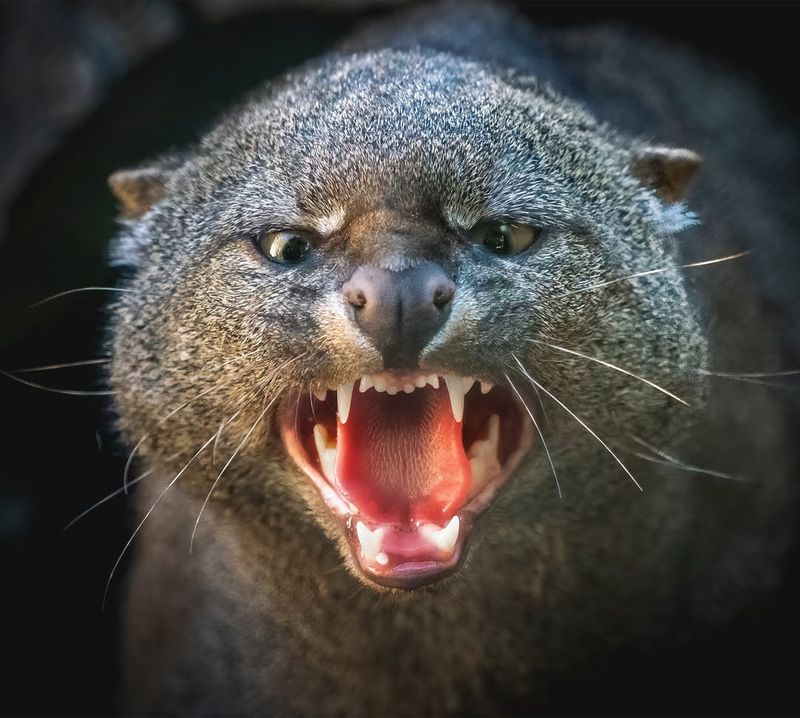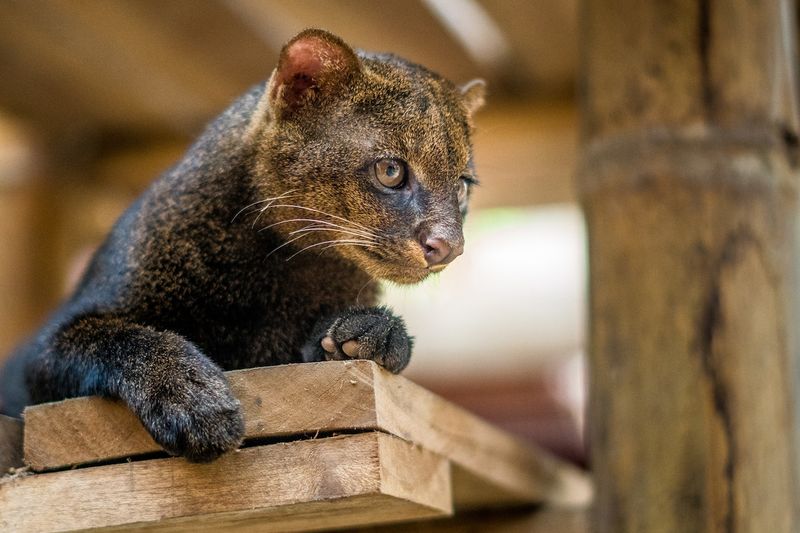📖 Table of Content:
Often overshadowed by its more famous feline relatives, Jaguarundi is one of the most intriguing and mysterious wildcats in the animal kingdom. Known for its elusive nature, this fascinating creature holds a treasure trove of secrets waiting to be uncovered.
Join us on an exploration of the jaguarundi’s hidden world as we reveal 9 shocking facts about this enigmatic wildcat. From its unique appearance and behaviors to its surprising adaptability and vocalizations, these secrets will offer a deeper understanding of a cat that remains largely unknown to the world.
1. Unusual Appearance
The jaguarundi’s appearance is unlike any other wildcat, resembling more a weasel or otter.
With its elongated, slender body, short legs, and a long tail, it defies typical feline characteristics. Its small, rounded ears and unmarked coat add to its unique look.
Found in shades of gray, red, or brown, the jaguarundi’s fur color can change, adapting to different environments. This camouflage aids in hunting and avoiding predators. Its enigmatic look is one reason why this wildcat often goes unnoticed, blending into its surroundings with ease.
2. Diverse Vocalizations
The jaguarundi is not just elusive, but also vocal.
With a repertoire of sounds, it communicates through whistles, purrs, and even bird-like chirps. These vocalizations vary in meaning, from expressing distress to calling for a mate.
Unlike other wildcats, the jaguarundi’s vocal range is remarkably broad, enabling them to convey emotions and intentions effectively. This unique trait adds another layer to their mystique, as their calls often go unnoticed by those unfamiliar with their diverse sounds. They speak a silent language of the wild.
3. Master of Adaptability
Jaguarundis are exceptional survivors, adapting to various environments across the Americas.
Found from dense rainforests to open savannas, they showcase remarkable versatility. Their diet is equally diverse, consuming small mammals, reptiles, and birds.
This adaptability is key to their survival, allowing them to thrive in rapidly changing habitats. They are not just hunters but opportunists, making the most of available resources. Their ability to blend into different ecosystems is a testament to their evolutionary success, making them true masters of adaptability.
4. Solitary Lifestyle
Unlike many wildcats, jaguarundis prefer a solitary life.
They mostly hunt alone, marking their territories with scent to ward off others. This solitude offers them the freedom to roam and hunt without competition.
However, they are not entirely antisocial. During mating season, these elusive wildcats seek partners, temporarily breaking their solitary habits. This balance between solitude and social interaction is a fascinating aspect of their behavior, highlighting their independence yet occasional need for companionship.
5. Daytime Activity
In contrast to most wildcats, jaguarundis are diurnal, active during the day.
This unusual behavior helps them avoid competition with nocturnal predators. Daytime activity allows them to hunt when many potential threats are resting.
Their keen eyesight and stealth make them effective hunters under the sun’s watchful gaze. This trait sets them apart, providing insights into their unique survival strategies and ecological niche. Their daylight adventures are key to understanding their role in the ecosystem, illustrating their adaptability.
6. Wide Distribution
Jaguarundis boast an extensive range, found from northern Argentina to the southern U.S.
This wide distribution is a testament to their adaptability and survival skills. They inhabit diverse ecosystems, from tropical forests to dry shrublands.
Their presence across such varied climates and terrains showcases their resilience and ability to thrive in different environments. Understanding their distribution helps in conservation efforts, ensuring these elusive wildcats continue to roam freely, maintaining the ecological balance in their habitats.
7. Mysterious Ancestry
The jaguarundi’s lineage is as mysterious as its lifestyle.
Genetic studies suggest they diverged from other cats about three million years ago. This ancient ancestry includes links to both the cougar and the cheetah.
Their evolutionary path remains partially shrouded in mystery, fueling curiosity about their origins and adaptations. This enigmatic ancestry adds to their allure, making them a subject of fascination for scientists and wildlife enthusiasts. Understanding their past offers insights into their current behavior and role in the ecosystem.
8. Elusive Nature
Elusiveness is the jaguarundi’s hallmark.
These wildcats are masters of stealth, rarely seen even in their natural habitats. Their elusive nature aids in avoiding predators and surprises prey.
This skillful camouflage makes them one of the least observed wildcats, adding to their mystique. Researchers often rely on camera traps to study them. Their ability to vanish into their surroundings is a vital survival tactic, ensuring they remain the mysterious ghost of the jungle.
9. Conservation Challenges
Despite their adaptability, jaguarundis face significant conservation challenges.
Habitat destruction and deforestation are major threats, reducing their natural range and resources. Human encroachment further exacerbates these issues.
Conservation efforts are crucial to preserve their habitats and ensure their survival. Raising awareness about these challenges can aid in conservation initiatives, protecting the jaguarundi’s future. These efforts are vital for maintaining biodiversity and ecological health, highlighting the importance of preserving these enigmatic creatures.









